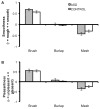Perceptual and neural response to affective tactile texture stimulation in adults with autism spectrum disorders
- PMID: 22447729
- PMCID: PMC3517930
- DOI: 10.1002/aur.1224
Perceptual and neural response to affective tactile texture stimulation in adults with autism spectrum disorders
Abstract
Autism spectrum disorders (ASD) are associated with differences in sensory sensitivity and affective response to sensory stimuli, the neural basis of which is still largely unknown. We used psychophysics and functional magnetic resonance imaging (fMRI) to investigate responses to somatosensory stimulation with three textured surfaces that spanned a range of roughness and pleasantness in a sample of adults with ASD and a control group. While psychophysical ratings of roughness and pleasantness were largely similar across the two groups, the ASD group gave pleasant and unpleasant textures more extreme average ratings than did controls. In addition, their ratings for a neutral texture were more variable than controls, indicating they are less consistent in evaluating a stimulus that is affectively ambiguous. Changes in brain blood oxygenation level-dependent (BOLD) signal in response to stimulation with these textures differed substantially between the groups, with the ASD group exhibiting diminished responses compared to the control group, particularly for pleasant and neutral textures. For the most unpleasant texture, the ASD group exhibited greater BOLD response than controls in affective somatosensory processing areas such as the posterior cingulate cortex and the insula. The amplitude of response in the insula in response to the unpleasant texture was positively correlated with social impairment as measured by the Autism Diagnostic Interview-Revised (ADI-R). These results suggest that people with ASD tend to show diminished response to pleasant and neutral stimuli, and exaggerated limbic responses to unpleasant stimuli, which may contribute to diminished social reward associated with touch, perpetuating social withdrawal, and aberrant social development.
© 2012 International Society for Autism Research, Wiley Periodicals, Inc.
Conflict of interest statement
None of the authors have conflicts of interest to declare.
Figures





References
-
- American Psychiatric Association. Dsm iv-tr. Diagnostic and statistical manual of mental disorders. 4. Washington, D.C: APA Press; 2000. text revision.
-
- Augustine JR. Circuitry and functional aspects of the insular lobe in primates including humans. Brain Res Brain Res Rev. 1996;22:229–244. - PubMed
-
- Baranek GT. Autism during infancy: a retrospective video analysis of sensory-motor and social behaviors at 9–12 months of age. Journal of Autism and Developmental Disorders. 1999;29:213–224. - PubMed
-
- Baranek GT, David FJ, Poe MD, Stone WL, Watson LR. Sensory Experiences Questionnaire: discriminating sensory features in young children with autism, developmental delays, and typical development. Journal of Child Psychology and Psychiatry, and Allied Disciplines. 2006;47:591–601. - PubMed
-
- Bastiaansen JA, Thioux M, Nanetti L, van der Gaag C, Ketelaars C, Minderaa R, Keysers C. Age-related increase in inferior frontal gyrus activity and social functioning in autism spectrum disorder. Biological Psychiatry. 69:832–838. - PubMed
Publication types
MeSH terms
Substances
Grants and funding
LinkOut - more resources
Full Text Sources
Medical

